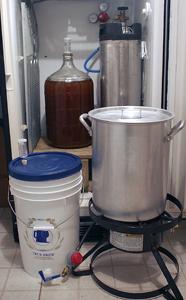
For the average college student, 20 bucks will buy you a case of decent beer that lasts for a weekend. One student, however, has found 20 bucks can make him enough beer to last a couple weeks.
With a brew pot, a primary fermenter with airlock and stopper, secondary fermenter, a plastic hose, pipon and a soda keg, Preston Mokris, a junior in business management, has found a hobby in brewing his own beer.
Technician: Why did you want to start brewing your own beer?
Preston Mokris: Honestly, the main reason I started making beer was because I drink my fair share [of it] and I have always been curious about how it is made. When you do a lot of something you tend to be curious of the process it takes to make the product you’re using.
Technician: How did you figure out you were definitely going to do this?
PM: After doing research with my roommate, Tyler Holcombe, we found many beginner kits that average around a price of $100, which includes one batch of beer but not the kegerator. After we found this out, we decided to go forth with it.
Technician: Where did you find most of your supplies?
PM: The main store we got all of our ingredients and supplies from is American Brewmaster located right here in Raleigh. They were great help and very informative on any part of the beer-making process.
Technician: So what is the first step in making beer?
PM: For starters, to make a beer you need to know what kind of beer you want to make. For example, we both really like J.W. Dundee’s Honey Brown so we decided to make that as our first batch. Our last batch we made was in hopes for it to taste like a Rolling Rock. It’s not ready yet, so we’re curious to find out.
Technician: What were the main ingredients in the Rolling Rock batch?
PM: The main ingredients for the Rolling Rock was1.5 bags light malt extract1 bag rice sugar2 bags Hallertauer HopsEuropean Lager Yeast
Technician: Explain how you brew the beer as simple as possible?
PM: For the Rolling Rock, the process to make it was we took our brewing pot — recommended to be three gallons or more — and we put about 1.5 gallons of water in it to mix the ingredients. Next, we brought the water to a boil and then added the first ingredients.
The first ingredients for this specific beer were light malt extract, rice sugar and one bag of the Hallertauer hops. The main ingredients for beer are the hops because it gives it its smell and main flavor. You let this boil for approximately 50 minutes. After 50 minutes you add another bag of the Hallertauer hops for 10 minutes.
After 10 minutes, take the pot off the burner and let cool until it’s room temperature. The recommended way to cool this is fill the sink with ice water and put the pot in it. While the pot is cooling, activate the yeast by putting warm water in a cup and adding the yeast.
When the pot is cooled, add approximately 3.5 more gallons for a total of five gallons. Then add the yeast and stir for about a minute. The stirring is very important because it adds oxygen to the mixture to allow the yeast to ferment — to make alcohol.
Technician: How do you ferment the beer?
PM: After this, transfer the mixture to the primary fermenter — at least a five gallon airtight container with airlock and stopper on top. Airlock and stopper are mandatory because it will not allow oxygen in and lets out carbon dioxide, which is what the yeast is letting off while fermenting.
Allow the mixture to sit for approximately a week. This will allow the yeast to ferment, making the alcohol and also allowing the excess sediment to go to the bottom.
Transfer to secondary fermenter — a five gallon glass carboy with airlock and stopper. Allow to sit for approximately two weeks. We then transfer the beer into a soda keg using a siphon.
Technician: How do you carbonate the beer?
PM: When the beer is in the soda keg we hook it to a CO2 tank in the kegerator and turn it up to about 15 psi depending on the temperature. The beer should be carbonated at serving temperature. It should be carbonated in about four to five days.
The beer is then ready to serve, however the longer the beer sits the clearer and better the taste will be. The total process of making beer is estimated to be one month and having a kegerator optional. If you do not have a kegerator you can always transfer the beer into sanitized bottles. The process to carbonate this is put one teaspoon of corn sugar in each bottle and allow to sit for a week. Then enjoy.
Technician: How often do you brew beer?
PM: Tyler and I make a batch every other week so we have two weeks to drink a batch but mostly this allows for the second fermentation to complete. It’s about 20-25 dollars to make a batch and takes about 1 1/2 hrs to make one. We keep doing it because it is fun, it’s cheap, it doesn’t take long and it turns out to be better than average tasting beer.